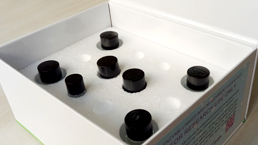Two-step Immunohistochemical Support Pack(anti-Rabbit/Mouse IgG)
Instruction manual
First Edition (Revised on April, 2016)
[PRODUCT INFORMATION]
HRP labeled secondary antibodies combine with primary antibodies (from rabbit or mouse) on a tissue section to form immune complex. HRP on the antibody can catalyze the reaction of substrate H2O2 with DAB and ultimately to form brown (or red) insoluble chromogen. The target molecular is marked in tissue and cells, and the final site is determined by microscopy.
[REAGENTS AND SPECIFICATION]
NO. | Component | Specification | ||||
| 1 | Endogenous peroxidase blocking solution | 3mL | 6mL | 18mL | 55mL | 110mL |
| 2 | HRP labeled anti-Rabbit/Mouse IgG | 3mL | 6mL | 18mL | 55mL | 110mL |
| 3 | Blocking serum working solution | 3mL | 6mL | 18mL | 55mL | 110mL |
| 4 | Hematoxylin stain | 3mL | 6mL | 18mL | 55mL | 110mL |
| 5 | Sodium citrate antigen repair solution (20×) | 10mL | 20mL | 60mL | 200mL | 400mL |
| 6 | Chromogenic agent (1×) | 3mL | 6mL | 18mL | 55mL | 110mL |
| 7 | DAB solution (50×) | 60μL | 120μL | 360μL | 1.1mL | 12.2mL |
[APPLICATION]
This product is only used for immunohistochemistry experiment, suitable for manual and machine mass operation. The reagents only verify for 10% neutral buffered formalin fixed paraffin embedded tissues, and not for others.
[STORAGE AND DEADLINE]
Store at 2~8℃, and the shelf life is 6 months.
[EXPERIMENTAL STEPS]
1.Equipments and reagents
a) Pipette, incubator, repair apparatus, immunohistochemistry pen, timer, incubation box, dyeing rack, coverslip, optical microscope, washing bottle.
b) Prepare DAB working solution by diluting DAB solution(50×) with Chromogenic agent.
c) Prepare Sodium citrate antigen repair working solution by diluting Sodium citrate antigen repair solution(20×) with ddH2O.
2. Experimental steps
(1) Baking slice: Mark with a pencil and bake at 65℃ for 1-2 hours.
(2) Dewaxing: After drying, the paraffin sections are sequentially put in xylene I, xylene II for 30min, 100%, 100%, 95%, 80%, 70% ethanol for 10min, and then put into pure water for 10min.
(3) Antigen repair:
Microwave method: Put a certain amount of sodium citrate antigen repair working solution(0.01M, pH6.0) into microwave,and heat it to boiling. Then put the slice into the boiling buffer, handle with low fire for 3 minutes. Place it for 8 minutes and then handle with low fire for 3 minutes. Remove water and cool it, take the slice, wash with distilled water for twice, and then wash it with PBS for 3 times for 3 minutes each.
(4) Blocking of endogenous peroxidase: Add a proper amount of endogenous peroxidase blocking solution, incubating at room temperature for 10 minutes. And wash with PBS buffer 3 times for 3 minutes each..
(5) The closure of non specific sites: Shake off the residue and cover slices with Blocking serum working solution about 100-200μL, incubating at room temperature for 20min.
(6) Add Primary antibodies: Add 100-200μL of primary antibodies (from rabbit or mouse) according to the size of the tissue, incubating for at 37℃ for 60min. Wash it with PBS buffer for 3 times for 3 minutes each.
(7) Add 100-200μL of HRP labeled anti-Rabbit/Mouse IgG, incubating for 30 minutes at 37℃. Wash it with PBS buffer 3 times for 3 minutes each.
(8) Coloration: Add a proper amount of fresh DAB working solution, incubating for 30 seconds-10 minutes at room temperature, and terminate the reaction according to the color under the microscope.
(9) Redyeing: Wash with water, and add hematoxylin stain incubating for 0.5-2 minutes. Add 1% hydrochloric acid for 3 second, and wash with PBS to become blue.
(10) Dehydration, transparent, mounting
(11) Microscopic observation, photographing.
[IMPORTANT NOTES]
1. During dyeing, blank and negative control experiment must be carried out simultaneously.
2. If positive tissue control can not show appropriate positive staining, the results should be invalid.
3. If the HRP labeled anti- IgG antibody is incubated for high temperature or long time, it could lead to excessive dyeing and background staining.
4. Red blood cells and cytochrome C may cause a false positive results.
5. If the dewaxing is incomplete, and it would affect the dyeing. It is suggested that separate the immunohistochemical section dewax from the conventional HE dewaxing.
6. Set up positive and negative control to avoid false positive and false negative results.
7. Over much PBS buffer will dilute reagents, which will reduce dyeing effect. Therefore, remove excess buffer before adding reagents.
8. In the process of operation, please wear gloves, glasses and lab clothes, follow experimental process, and do protective measures.




